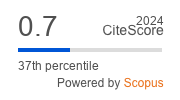Treatment of Nasopharyngeal Carcinoma by Using Deep X-Ray Therapy
Keywords:
Nasopharyngeal Carcinoma (NPC),, Radiotherapy (RT).Abstract
Background: Nasopharyngeal carcinoma (NPC) is one of the most challenging tumors because of their relative inaccessibility and that their spread can occur without significant symptoms with few signs, but Radiotherapy (RT) has a role in treatment of it.
Objectives: To show that RT is still the modality of choice in the treatment of NPC, to study modes of presentations, commonest histopathological types and their percentages, to show differences in the sensitivities of these types to RT and to find out a 5 year survival rate(5YSR) and its relation with lymph node involvement.
Methods: This is a retrospective study of 44 patients with NPC who were treated with routine RT from 1988-2007 at the institute of radiology and nuclear medicine. All patients were treated with megavoltage x-ray with a total dose to the primary lesion was 60-70 Grays (1 Gray = 100 Rads) so we gave 6000-7000 Rads in 6-8 weeks and 50 Grays were applied to the cervical lymphatic chain bilaterally.
Results: 10 out of 44 patients treated have survived more than 5 years (with a 5YSR of 22.7%). In this series of cases, the 5- year overall survival rate is: 60% with stage I, 33.3% with stage II, 28.5% with stage III and 13.7% with stage IV. But, it should be noted that most of them were advanced with stages III and IV accounting for 36 patients i.e 81.8%.
Conclusion: Radiotherapy (RT) is the modality of choice in the treatment of NPC and we must irradiate areas of probable spread with the primary lesion because spread can occur without significant signs and symptoms .The most common histopathological type is undifferentiated carcinoma which is more sensitive to RT than squamous cell carcinoma (scc) or other types of carcinoma.
Also we see that stages III and IV NPC (advanced) comprises high number of the total and the 5-YSR decreases as the patient advances from stage I to stage IV, therefore, early detection and diagnosis is very important.













